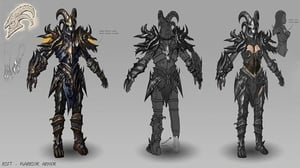Award-winning Concept Artist, Illustrator and CG Spectrum Mentor, Tyler James shares advice on how to become a concept artist. Tyler's got some serious street cred having worked with major developers and triple-A franchises, plus clients such as Blizzard Entertainment, Cryptozoic, and Fantasy Flight Games.
His art has become widely recognized on the internet and used for major character designs in game development. You can find his work in titles like Heroes of the Storm, Warhammer, Rift, Star Wars, Hex, Warmachine, Wasteland, Warcraft, Rift, and RWBY.

Warrior Armor, Rift Concept Art, Tyler James
Tyler, how did you become a concept artist and illustrator?
Becoming a concept artist and illustrator is a lot of hard work. Luckily the effort always feels more palatable when it’s something you’re very passionate about. People are said to succeed most at things they have a passion for, and for me it developed early playing video games and watching films filled with amazing fictional creatures. I drew a lot as a kid. I collected comics and played Magic the Gathering which were great sources of inspiration before I started formal art training in college at the Art Institute. The curriculum was a good starting point but I paired it with lots of additional classes in figure drawing and character design. I also attended Concept Design Academy after graduating.
The key to becoming a successful concept artist is to digest as much art as you can, learn from your peers, and put in the pencil mileage!
 Heroes of the Storm, Art by Tyler James
Heroes of the Storm, Art by Tyler James
For those who may not know, how do you describe concept art vs illustration?
Concept art requires a more complete understanding of the function your design will play in the end production. As such, it fundamentally acts more like a schematic for others to interpret. You’ll find yourself creating drawings from multiple angles of the same piece, working closely with other parts of the team like 3D modelers, and iterating a lot on your designs to meet the needs of the whole. Concept art often benefits from tangential knowledge in fields like industrial design, fashion design and the sciences.
Illustration brings in a completely unique set of challenges. If concept art is the creation of the ingredients of a recipe, illustration is the final plate that arrives for someone to taste. The composition plays a giant role in this and how it will affect the narrative you are trying to convey. How elements fit within the frame and their relationship to each other all affect the path of the viewer’s eye through your vision.
 Elven Village by Tyler James
Elven Village by Tyler James
How do you describe your art style?
That’s always a tough one. As a concept artist I try to have some flex in terms of style, leaning sometimes more into realistic rendering, other times going very stylized. I’m heavily influenced by Brom, Frazetta, Paul Richards, Joe Mad, Paul Bonner, Alphonse Muccha, Katsuya Terada, H.R. Giger, Simon Bisley, Edouard Guitton, Simon Lee, Eric Canete and a handful of others.
See the influence map below for a visual guide.

How do you get concept artist work with clients like Blizzard or Cryptozoic?
The best way is to just put yourself out there on the internet. Often times clients will see your work and reach out to you. If there is a particular project or team you are interested in, send them an email with a link to your portfolio. You’d be surprised sometimes the response you get! Try to include works that are similar to their target if you can. Studios will often allow for an art test to ensure a good fit. I’ve had the great fortune of working with many amazing clients over the years; Blizzard Entertainment, Cryptozoic, Fantasy Flight Games, Trion Worlds, Privateer Press, Applibot, Direwolf, WOTC, Inxile etc.
Tell us about 3 of your favorite pieces:
Two of the three would be illustrations and one is a concept piece. The first is a fan piece I did for Diablo 3 when the game first came out. I was working on Rift at the time and my piece was featured in an article on Kotaku titled ‘Diablo as imagined by a Rift Concept Artist.’ It got featured a lot on the internet and on the official Blizzard fan page. I was really pleasantly surprised how well it was received and it gave me a great boost of confidence to keep making fan art for my favorite games.
 Diablo 3 Fan Art by Tyler James (featured on Kotaku)
Diablo 3 Fan Art by Tyler James (featured on Kotaku)
The second is a piece I call The Fortune Teller. It’s pretty old at this point but I include it simply because it was a bit of a turning point for me, when I first became really comfortable with digital painting and rendering more convincing materials and lighting. I also really enjoy the theme of the piece.
 The Fortune Teller, Tyler James
The Fortune Teller, Tyler James
Lastly, my design of Regulos for Rift was a ton of fun to work on. The team was just starting to explore ideas for the fight which was the very last raid boss intended to be the top tier of difficulty for players. It wasn’t long after our first meeting that I had a dream where I imagined this giant creature whose head could open up to reveal a smaller ‘driver’ inside. There’s plenty of examples of this kind of idea in entertainment design but it wasn’t something the team had considered at all. I felt it would be pretty compelling since the players already knew Regulos in his regular human-sized form but we needed a giant boss for the fight. The ‘head crack’ would reveal the Regulos players knew from before and connected him quite literally with what we needed for the encounter. The final design went on to be modeled by the amazing 3d artist Hai Phan who now works on Overwatch and modeled some characters people might recognize like Mercy, Reaper and Hanzo. Go check him out!
 Rift's Regulos concept art, Tyler James
Rift's Regulos concept art, Tyler James

What is your concept art process from brief to delivery?
It’s important to understand your client’s expectations. If you’re doing concept art, you need to consider how broad your approach should be in your first round of designs. This first pass is your ‘shotgun blast’. Later you’ll be more like a sniper, hitting your target with laser accuracy. Keep them as loose as your director will allow. For illustrations, I try to provide a few rough compositions with enough information to convey the attitude of the characters and their relationship with the environment. If I’m trying something more daring with the lighting I’ll also try and indicate that in the rough stage. With each review from the client I work tighter until at the polish stage. I work with minimal layers to try and stay connected to my piece but I do keep certain things separate so changes aren’t a hassle.
How can one become a better concept artist? What skills or traits do you need?
I like to imagine the traits kind of like power meters, a bar graph of skills. You want to try and keep your meters evened out so you don’t have any major weaknesses. Now of course this is much easier said than done. We all have our favorite styles and areas of exploration. Some people love to draw realistic humans. Others like very stylized work or maybe drawing only animals. As a concept artist, it always helps to have a broader understanding of subject matter and styles, but it's OK to have a favorite. Just try to be realistic about what projects you can contribute to given your focus. I think the three most important areas of study for Concept Artists are design, anatomy and materials/ lighting.
 Rift concept art, Regulos Raid Weapons, Tyler James
Rift concept art, Regulos Raid Weapons, Tyler James
What advice do you have for someone considering a job as a concept artist?
It’s true, concept art is a very competitive industry. There are some clichés to fall back on here: doing what you love will ultimately lead you to your dream career and your passion will drive your success but those are only part of the equation. You will need to be diligent about making connections with people. Attend school, go to meet-ups with other artists. Talk with industry professionals at conventions and share your work on the internet. The minimum bar of entry is being good at your craft so the time you spend learning and training will never be wasted.
You have an incredible concept art and illustration portfolio on your website, Art of Ty. What's your favorite platform for promoting work?
Well, thank you! As an artist though, I only see all the flaws in my own work. Such is the life of an artist, an unending journey of self-critique. But hey, that’s how you get better! My favorite place to share my work is on Instagram (@artofty). It feels like a casual platform with a great community of creative people and it has better organic reach than other platforms like Facebook. I also recommend ArtStation (See Tyler's Artstation). You’ll see an infinite amount of inspirational work on there!
 Hearthstone Treasures of Booty Bay, Tyler James
Hearthstone Treasures of Booty Bay, Tyler James
What 3 tips do you have for someone building their first concept art portfolio?
- Tip 1: Include only your BEST work.
- Tip 2: Include at least a couple of pieces that exemplify the style your client is looking for.
- Tip 3: Have a minimum of 20 pieces demonstrating capable skills in design, anatomy, and materials/lighting. If you are doing environments, make sure your perspective is accurate. (Bonus for examples of convincing mechanical and industrial design!)
What should people wanting to study concept art look for in a course?
There are a lot of resources out there for concept artists to learn from. Unfortunately, they vary dramatically in quality and it is critical that you learn from the best sources.
Your time is very precious and running in circles is the last thing you want to do trying to jump start your concept art career.
Here is probably the best place to explain why I chose CG Spectrum for my class. The program offers small class sizes and in-depth personal feedback all along the way.
The instructors are all veterans who have worked in the industry and provide targeted information to keep you learning at a good pace. It’s like an adrenaline shot to your progress.
In addition, we have options for beginner and more advanced students along with the comfort and convenience of learning right from your home. It doesn’t get much better than that.
Any other words of wisdom you'd like to add, Tyler?
In the words of a great media icon, “Stay thirsty my friends.”
 The Emerald Nightmare, Tyler James
The Emerald Nightmare, Tyler James
To learn more about this career path, read What is Concept Art? And enjoy more of Tyler's work at the Art of Ty and on Instagram: @artofty.
Want to become a concept artist?
Don't miss this amazing opportunity to study concept art from amazing mentors like Tyler James. CG Spectrum offers beginner and advanced digital art courses that prepare you for a career in the entertainment industry. Fast-track your education by learning from the best!

Related Links




